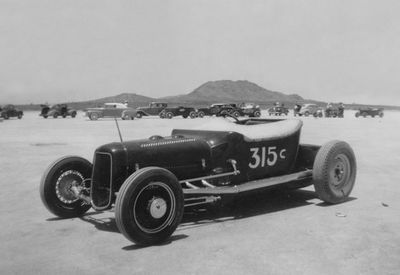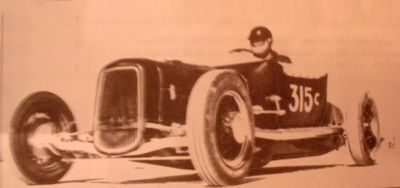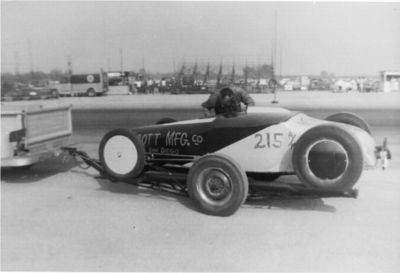Paul Schiefer's 1925 Ford Model T Roadster


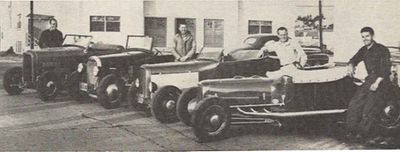














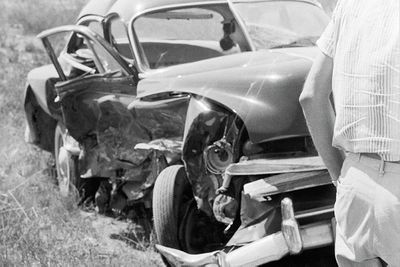
1925 Ford Model T Roadster owned by San Diego Roadster Club member Paul Schiefer of San Diego, California. The Schiefer roadster is one of the few cars campaigned on the lakes and the strips that, within a decade, saw its first-year top speeds on the dry lakes exceeded by its later 1/4-mile ETs.
Contents
The Early Days
Paul's friend Jack Osborne recalled the car being built in Paul's garage. It was built on a tube frame fabricated from the wing struts of a PBY-5A Catalina flying boat. The body was channeled about 4 inches. Everything else was fairly standard.[9] The wheels were typically 16-inch and/or 18-inch Ford wires with 1934 Ford V8 hubcaps; at the front end was a Chrysler tube axle with Ford spindles and Ford steering arms/links. A gear mounted at the right front wheel spun a Stewart speedometer positioned next to a Stewart tach in the middle of the dash; to the left side was a smaller temperature gauge, and on the right was an equally small oil pressure gauge[10]; the rear end was from a Model 'A' and had a home built quick change gear in front of the rear axle. The quick change was built by Bob Bubenik in Paul's garage. The car was powered by a 286 engine that made 235 hp on the dyno in Paul's shop. The engine ran straight alcohol. The headers were also built in the shop.[11][12]. The transmission was a 1935-1939 Ford three-speed, and the steering gear assembly may have been built by Gordon Schroeder. In 1947 the car was powered by a 286 cid 1947 Mercury engine with Edelbrock heads and manifold, Harman & Collins cam, and Pounden ignition. In 1948, the Pounden Ignition was replaced by an Eddie Meyer Ignition.[13] When Paul's roadster appeared at the last SCTA meet in 1947 it was judged the Best Appearing Car. The flywheel exploded at that meet.[14]
Schiefer Manufacturing Company
At the SCTA July 18, 1948 meet, Paul's roadster with Butch Ludwig behind the steering wheel was the fastest C-Class roadster at 148.02 mph. This was also Paul's best run in 1948. Paul used his roadster as a test vehicle for the development of an aluminum flywheel which became the first major product of the Schiefer Manufacturing Company.[1] Paul used a Ford truck grille on his roadster. It was dark blue and rode on a custom tube chassis using a custom tube front axle with 5x16 grooved tires in the front. The body featured a full belly pan and a three-piece custom louvered hood.
Body Swap
Paul ran his roadster at the 1947 Lakes meet as no. 10. In 1948, he ran it as no. 315 and at the first meets in 1949 as no. 7[4]. After seeing the record speed Don Waite's 1927 Ford Model T Roadster accomplished in 1949, he changed the body to a more streamlined 1927 Ford Model T roadster. The rear tires were originally made for an Indy race car. Painted red, this body was channeled about six inches over the frame. The nose was fabricated in Paul's garage, and it featured a grille that may have been made by Eddie Kuzma[15]. After swapping bodies, the class C Lakester stopped the clocks at an excellent 156.74 mph. The records were set using the same 286" Mercury engine with Edelbrock and Harman equipment.[1]
The Bean Bandits and Rear Engine Conversion
By 1951, the car was repainted medium blue, sported Halibrand magnesium disc knockoff rims in the rear, and motorcycle wires up front. Paul ran his Class C Modified Roadster at 150.753 mph for the 8th in class at Bonneville. Later he loaned his roadster to the Bean Bandits Racing Team, and Joaquin Arnett raced the car for a while. Joaquin was the one who made it into a rear-engine roadster. A photo from the Dick Kraft Collection displayed at the AHRF website shows the roadster on Bonneville in 1953. As no. 676 in Class C, powered by a 274" '49 Merc flattie, the car finished third in class with a speed of 180.36 mph.[7] The car was returned to Paul Schiefer after the Bean Bandits had raced it.[16] Red Henslee picked up the car, motivating it with a 392 Hemi backed by a Ford two-speed manual gearbox. At first, Henslee partnered with Holly Hedrich and then Emory Cook. In 1956, it became the most famous roadster of the 1950s when it set the 1/4 mile World's drag racing record at 157.15 mph.[1].
Cook and Henslee
In his book, Tales from the Drag Strip, Don Garlits tells about what was, most likely, the pitiful but glorious end of this fine car; "Emory Cook was the first driver to develop the high-gear-only concept back in the 1950s. He and Red Henslee were running their roadster at Santa Ana one day, and the two-speed Ford transmission they were using broke. When it got time for Top Eliminator, Cook said he didn't want to give up a shot at the trophy, plus a possible $25 for winning. He told Henslee, 'Let's just go up there and run it in high gear, and maybe the other guy will leave too soon or break or who knows what.' Cook got up to the line, revved it up, and spun the tires, and sonavabitch, if he didn't set top speed of the meet and win! So they knew then that just running in high gear could work. The crowd was going crazy, and down at the far end, Henslee was so excited that he told Cook he wanted to be behind the wheel of the car as it was pushed back down the return road. But something goofy happened as they were coming back. They must have accidentally started it, and Henslee crashed. Cook was so mad when Henslee crashed their roadster that the partnership was over for good." [17]
The End? Wrecked at Paradise Mesa Drag Strip in 1957
According to an article published in Hot Rod Deluxe March 2016, George Barcout was racing Red Henslee's roadster down the 1/4 mile at Paradise Mesa Drag Strip in 1957 when a spectator unknowingly drove his Chevrolet sedan across the strip. Barcout T-boned the errant spectator, shattering the roadster into pieces all over the place. This was George's first ride in the car. "I was in the tower," Dick Lechien, the announcer, told Hot Rod Deluxe Magazine. "I had to run the quarter-mile to get down there. I jumped into the ambulance and went to the hospital with him. He had so many broken bones, I didn’t think he would make it, but he did."[18]
Magazine Features and Appearances
References
- ↑ 1.0 1.1 1.2 1.3 1.4 1.5 1.6 Hot Rods in the Forties
- ↑ The American Hot Rod Foundation - The Jack Calori Collection
- ↑ SCTA - Fantastic Photos taken at a 1948 SCTA Meet
- ↑ 4.0 4.1 4.2 4.3 4.4 4.5 www.ahrf.com
- ↑ Society of Land Speed Racing Historians Newsletter 149 - February 4, 2010
- ↑ 6.0 6.1 6.2 6.3 Vintage Hammer Garage
- ↑ 7.0 7.1 The American Hot Rod Foundation -Joe Henning Mystery Collection
- ↑ High Performance: The Culture and Technology of Drag Racing, 1950-2000
- ↑ Jack Osborne
- ↑ Freddie Lobello
- ↑ Society of Land Speed Racing Historians Newsletter 148
- ↑ Jack Osborne
- ↑ Cite error: Invalid
<ref>tag; no text was provided for refs namedhard - ↑ The Birth of Hot Rodding
- ↑ Burke LeSage
- ↑ Cite error: Invalid
<ref>tag; no text was provided for refs namedslur - ↑ Tales from the Drag Strip with Bid Daddy
- ↑ Hot Rod Deluxe March 2016
Did you enjoy this article?
Kustomrama is an encyclopedia dedicated to preserve, share and protect traditional hot rod and custom car history from all over the world.
- Help us keep history alive. For as little as 2.99 USD a month you can become a monthly supporter. Click here to learn more.
- Subscribe to our free newsletter and receive regular updates and stories from Kustomrama.
- Do you know someone who would enjoy this article? Click here to forward it.
Can you help us make this article better?
Please get in touch with us at mail@kustomrama.com if you have additional information or photos to share about Paul Schiefer's 1925 Ford Model T Roadster.
This article was made possible by:
SunTec Auto Glass - Auto Glass Services on Vintage and Classic Cars
Finding a replacement windshield, back or side glass can be a difficult task when restoring your vintage or custom classic car. It doesn't have to be though now with auto glass specialist companies like www.suntecautoglass.com. They can source OEM or OEM-equivalent glass for older makes/models; which will ensure a proper fit every time. Check them out for more details!
Do you want to see your company here? Click here for more info about how you can advertise your business on Kustomrama.

